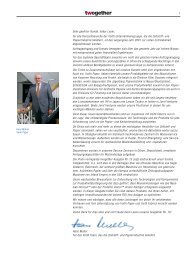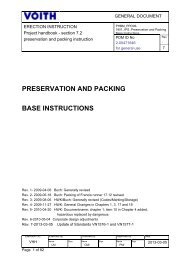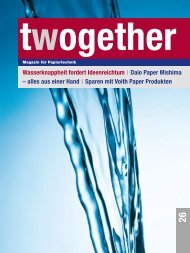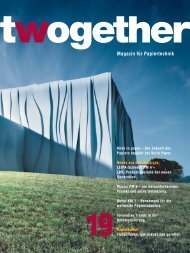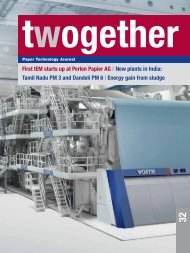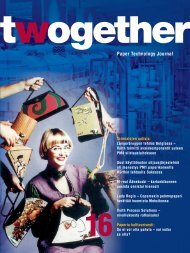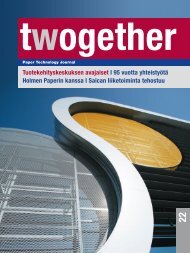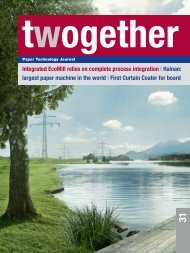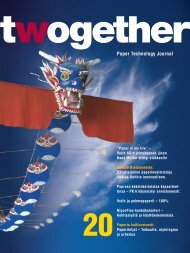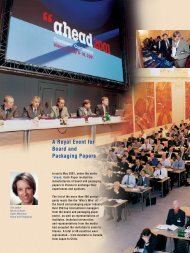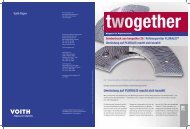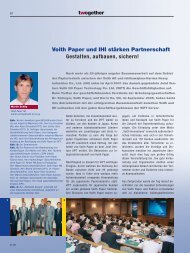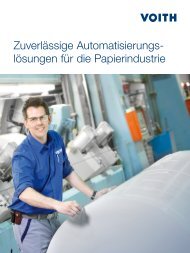Create successful ePaper yourself
Turn your PDF publications into a flip-book with our unique Google optimized e-Paper software.
2<br />
Specialists visited the mill and examined<br />
all current threading processes thoroughly.<br />
They discussed the threading difficulties<br />
with personnel at the mill and developed<br />
a detailed optimization plan based<br />
on their findings.<br />
The first problematic threading section<br />
was Dryer 52 to the last Coater ropes<br />
section. Originally, the tail was transferred<br />
into the rope nip by air nozzles located<br />
under a mini doctor blade. This<br />
system did not operate properly and required<br />
operator involvement when blowing<br />
the tail into the rope nip. The new solution<br />
from <strong>Voith</strong> TTG included a multiple<br />
VTT Turbo conveyor system to stabilize<br />
the tail, eliminate the double tail and to<br />
provide a reliable, controlled transfer into<br />
the rope nip. The VTT Turbo conveyors<br />
are built with internal turbines that generate<br />
a large amount of vacuum. These<br />
conveyors also include an internal Drum<br />
Drive for efficient operation and space<br />
savings. This section was rebuilt during<br />
the summer of 2002, approximately eight<br />
weeks before the main shut, allowing a<br />
smooth and efficient take-over for the operators.<br />
This contributed to a good startup<br />
after the main rebuild as the operators<br />
were already familiar with the new<br />
threading technology.<br />
The second optimized section was the<br />
Dryer to Size Press section. Again, the<br />
original system used air nozzles to blow<br />
the tail into the ropes. This manual sys-<br />
3<br />
Finishing<br />
tem was very unreliable and compromised<br />
operator safety. The optimized solution<br />
included a multiple VTT Turbo conveyor<br />
section with a Flip Tray transfer device<br />
and a Tail Ripper. The Flip Tray was<br />
mounted directly on the dryer cylinder<br />
doctor to allow for the movement of the<br />
scanners and other equipment. The purpose<br />
of the Flip Tray was to stabilize the<br />
tail during the transfer. The Tail Ripper<br />
was used to efficiently eliminate the double<br />
tail.<br />
The third section to be optimized was<br />
Dryer 2R to the 1st Coater Ropes section.<br />
Again, air nozzles were used in the original<br />
transfer. As the air nozzles were located<br />
under the doctor blade, the system<br />
didn’t operate properly and required operator<br />
involvement. The new solution included<br />
VTT Turbo conveyors, a Flip Tray<br />
and a Tail Ripper. In this section, the Flip<br />
Tray moves the tail onto the conveyor<br />
where the tail is kept under control and<br />
transferred into the rope nip. The rope<br />
nip was also relocated to allow for a better<br />
tail transfer into the coater ropes.<br />
The results of the optimization process<br />
were exceptional. Right after the system<br />
start-up, threading was successful 85%<br />
on the first attempt and 100% within<br />
three attempts. Threading times were<br />
also significantly reduced allowing for increased<br />
machine efficiency and production.<br />
Other benefits from the optimization<br />
included elimination of double tail, no<br />
Min<br />
30<br />
25<br />
20<br />
15<br />
10<br />
5<br />
0<br />
20<br />
Fig. 2: VTT Turbo conveyor<br />
installed at Condat.<br />
Fig. 3: Dryer to size press<br />
drawing; optimized threading<br />
at Condat.<br />
Fig. 4: Threading times before<br />
and after optimization.<br />
Before optimization<br />
After optimization<br />
10<br />
15<br />
5<br />
30<br />
15<br />
Coater 1 Coater 2 Film Press<br />
Sections<br />
43<br />
manual intervention, improved operator<br />
safety, limited maintenance requirements<br />
and space savings. <strong>Voith</strong> TTG took full<br />
ownership of the threading process during<br />
start-up resulting in a significant<br />
threading improvement.<br />
Within six months of the start-up, total<br />
time losses at the coater sections had<br />
been reduced by 35%. The optimization<br />
resulted in a significant 65% reduction in<br />
threading downtime. The mill and operators<br />
are also impressed with the reliability<br />
of the threading system and the effect<br />
the system has had on operator safety.<br />
The ultimate result of this optimization is<br />
a 4% increase in total machine efficiency.<br />
In a very short time, less than seven<br />
months, this installation has proven to be<br />
very successful. The co-operation between<br />
<strong>Voith</strong> and the customer Condat<br />
made it possible to reach all the deadlines<br />
and make this installation a true<br />
success.<br />
<strong>17</strong>/04<br />
4



